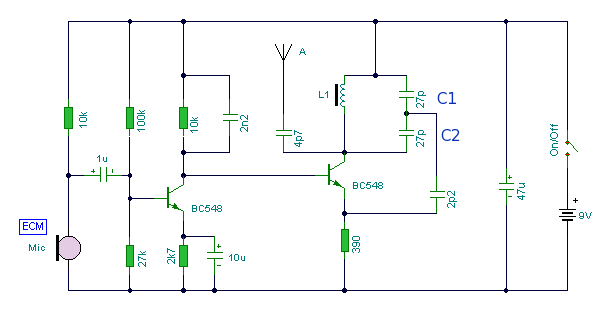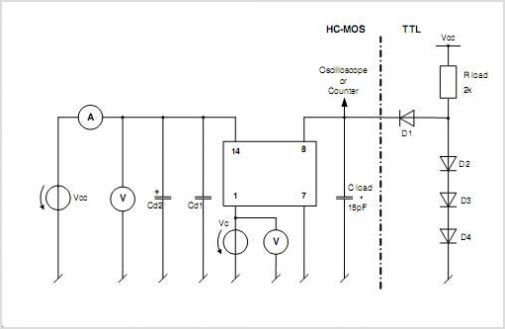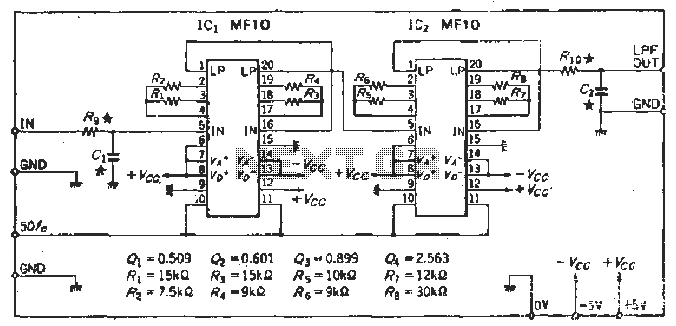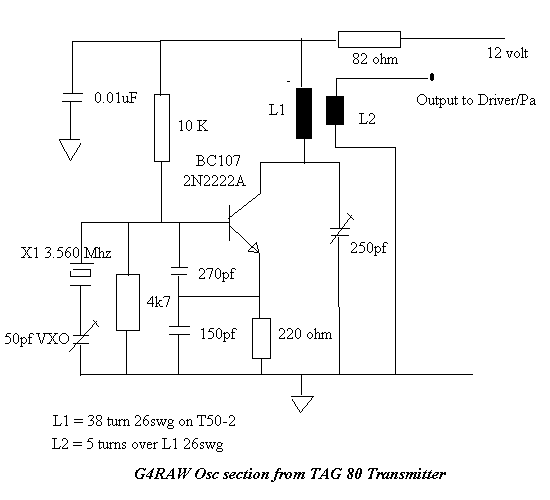
Resonant Frequency of a Colpitts Oscillator

This result places the oscillator within the UK FM Band, which ranges from 87.5 to 108 MHz. If L1 is equipped with an adjustable ferrite core, its inductance can be modified, allowing for fine tuning. If L1 consists of an air-spaced coil, fine tuning can be accomplished by physically compressing or separating the coil turns.
The oscillator circuit operates within the designated frequency range of the UK FM Band, utilizing a resonant tank circuit composed of an inductor (L1) and a capacitor (C1). The frequency of oscillation is determined by the formula:
\[ f = \frac{1}{2\pi\sqrt{LC}} \]
where \( f \) represents the frequency, \( L \) is the inductance, and \( C \) is the capacitance.
In this design, L1 can be an adjustable ferrite core inductor, which allows for precise control over the inductance value. By adjusting the position of the ferrite core within the coil, the magnetic coupling and thus the inductance can be finely tuned to achieve the desired frequency within the FM band. This feature is particularly useful for applications requiring accurate frequency settings, such as in radio transmitters or receivers.
Alternatively, if L1 is constructed as an air-spaced coil, fine tuning is achieved through mechanical adjustments. By physically compressing or separating the turns of the coil, the effective inductance changes, allowing the user to shift the oscillation frequency. This method, while less precise than the ferrite core adjustment, can still provide satisfactory tuning for many applications.
The circuit may also include additional components such as a variable capacitor (C2) for further frequency adjustments, as well as resistors and diodes for biasing and stability. The output of the oscillator can be connected to an antenna for transmission or to other stages of a radio receiver for further processing of the modulated signals.
Overall, the oscillator design provides flexibility and precision in tuning, essential for effective operation within the FM broadcasting spectrum.This result puts the oscillator in the middle of the UK FM Band (87. 5 - 108 MHz). If L1 has an adjustable ferrite core then its inductance can be altered and fine tuning acheived. If L1 is an air spaced coil then fine tuning is achieved by physically squeezing or separating the turns. 🔗 External reference
The oscillator circuit operates within the designated frequency range of the UK FM Band, utilizing a resonant tank circuit composed of an inductor (L1) and a capacitor (C1). The frequency of oscillation is determined by the formula:
\[ f = \frac{1}{2\pi\sqrt{LC}} \]
where \( f \) represents the frequency, \( L \) is the inductance, and \( C \) is the capacitance.
In this design, L1 can be an adjustable ferrite core inductor, which allows for precise control over the inductance value. By adjusting the position of the ferrite core within the coil, the magnetic coupling and thus the inductance can be finely tuned to achieve the desired frequency within the FM band. This feature is particularly useful for applications requiring accurate frequency settings, such as in radio transmitters or receivers.
Alternatively, if L1 is constructed as an air-spaced coil, fine tuning is achieved through mechanical adjustments. By physically compressing or separating the turns of the coil, the effective inductance changes, allowing the user to shift the oscillation frequency. This method, while less precise than the ferrite core adjustment, can still provide satisfactory tuning for many applications.
The circuit may also include additional components such as a variable capacitor (C2) for further frequency adjustments, as well as resistors and diodes for biasing and stability. The output of the oscillator can be connected to an antenna for transmission or to other stages of a radio receiver for further processing of the modulated signals.
Overall, the oscillator design provides flexibility and precision in tuning, essential for effective operation within the FM broadcasting spectrum.This result puts the oscillator in the middle of the UK FM Band (87. 5 - 108 MHz). If L1 has an adjustable ferrite core then its inductance can be altered and fine tuning acheived. If L1 is an air spaced coil then fine tuning is achieved by physically squeezing or separating the turns. 🔗 External reference





